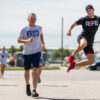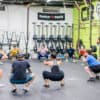I have had several conversations with different people over the past couple of months (mostly athletes new to weightlifting) and the subject of bent elbows during the clean and snatch keeps coming up so I figured I would talk about it. For the record regardless of how I explain this, I don’t think anyone should teach an athlete to bend the elbow on a pull, EVER! Sometimes it happens and sometimes it’s detrimental to the lift and sometimes it’s not. I’m going to talk a little about when you need to make a correction and when there are some instances that you can maybe let it go.
Pulling early with the arms is one of the biggest issues that I see with people that are new to weightlifting. This is generally due to a lack of the ability to express velocity through the hips. It’s not a knock on anyone, but generally athletes that have played a sport growing up that involves using the highs to generate power(think jumping in basketball/volleyball, down linemen blocking, throwing a baseball/football, track high/long jumpers) get it much faster. If an athlete has never had to express that type of movement they generally default to pulling with the arms because that is what they trust. They trust their arms to do the work because they don’t realize how powerful they are at the hips. This applies to everyone. In CrossFit we refer to it as a Core to Extremity violation. Simply put, CTE violations are using little muscles before big muscles. It’s the equivalent of trying to operate a gear train that is powered by the smallest gear first, instead of the largest gear. What happens? Speed rapidly decreases! When new lifters pull early with the arms there is almost a 100% chance that they will never reach full extension of the hip, thus blunting their power transference to the bar. The problem is the arms continue to pull on the bar for the duration of the lift and it counteracts the power generated at hip. Out of sequence=reduced power (not lifting nearly as much). These athletes need to work on clean/snatch pulls with emphasis on keeping the arms straight and making sure they get as tall as possible. This will help them develop the proprioception needed to understand how to use their hips to move large loads. It’s not easy for a lot of people so plan on this taking some time. Once they are pulling tall and getting the hips fully extended then have them start working other parts of the movement. Newer athletes should start with power movements first. The increased distance that is required to pull in the power movements emphasizes the explosiveness desired in weightlifting.
You will occasionally see some advanced lifters lifting with what looks like an early arm pull. Several pictures below show lifters with bent elbows in a variety of different positions of the pull on the clean and snatch. The difference here is simply what I would describe as tension and not pulling. Some lifters are bending the elbow in order to get it back in the hip crease before they begin their “jump”. This could be due to arm:torso length ratios, but not always. What they are not doing is continuously pulling up on the bar. They are simply working within their own lever system (their limb/torso lengths) to get to a certain position that allows them to create maximum mechanical advantage. The major difference between these two scenarios is the hips. The experienced athletes are getting the hips open fully and extending at the top of their pull. I would never teach this to an athlete, and you shouldn’t either. Some just do it and others do not. The HIPS are the real issue. If the pull negates the hip opening, then get in there and lock their elbows! If they are pulling with tension in the elbow and getting tall and finishing the pull you can probably leave it alone for the time being and address something else in the lift. Is it optimal to pull with bent elbows? Probably not. I could show you thousands of pictures of athletes hitting successful lifts and you would see both. But they are all getting their hips open!
Keep training hard and hit your weaknesses,
Fern





